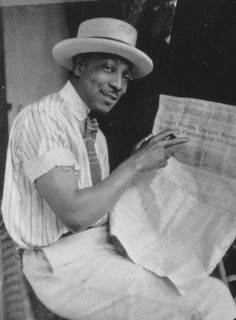“More human than human…”
arts and leisure, dining and cuisine, everyday glory, family and friends, food for thought, games, geekery, monkeys!, music, news and info, office antics, science and technology, sports, workout February 22nd, 2010“Ugh.”
That, literally, was my first thought upon waking up this morning. It was immediately followed by a line from the chorus of L.T.D.’s Back in Love Again:
Every time I move, I lose
I attribute all of this to the fact that my sides and thighs are achy from yesterday’s workout. Good for me? Yes. Good training? Yes. Builds character? Sure thing. But, no matter how you spin it, there’s still that pesky “sore from working out” factor to be dealt with. “That which does not kill me,” I guess…
Last night, SaraRules and I (finally) finished off the last two features on the Planet Earth DVDs. Both were pieces about conservation and sustainability. Both were, as with the entire series, done quite well.
Logan and Sanaz came over for a while after dinner. We had coffee and chatted – including a video-chat with Melissa – for a while. It was a nice way to wind down the evening. I also chatted with
Chew on This: Food for Thought – Black History Month
Today’s profile: James Van Der Zee
James Van Der Zee, a leading figure in the Harlem Renaissance, was an African American photographer best known for his portraits of black New Yorkers.
After attending schools in Lenox, he went to New York City (c.1906). Arriving in Harlem as an aspiring violinist, he formed—and performed with—the Harlem Orchestra. From 1909 to 1915 he played in Fletcher Henderson’s band and the John Wanamaker Orchestra (and in an orchestra that accompanied silent films).
On regular return visits from Harlem to his hometown of Lenox, Massachusetts, VanDerZee found himself shooting pictures of the beloved place as a hobby. In 1915 he landed a job as a darkroom technician, and after learning the fundamentals of photography he opened his own studio in Harlem (1916). In 1932, he outgrew his first studio and went on to open the larger GGG Studio, with his second wife as his assistant (since closed, but the building with its original sign can still be seen on the east side of Lenox Avenue between 123rd and 124th Streets in Harlem).
VanDerZee’s work exhibited artistic as well as technical mastery. Thanks to his genius for darkroom experimentation — retouching negatives, for example, and creating double exposures — the demand for his portraiture soon skyrocketed.
Aside from the artistic merits of his work, Van Der Zee produced the most comprehensive documentation of the period.
Although Van Der Zee photographed many of the African American celebrities who passed through Harlem, most of his work was of the straightforward commercial studio variety – weddings and funerals (including pictures of the dead for grieving families), family groups, teams, lodges, clubs, or people simply wanting to have a record of themselves in fine clothes. Many of VanDerZee’s photographs celebrate the life of the emergent black middle class. Using the conventions of studio portrait photography, he composed images that reflected his clients’ dignity, independence, and material comfort, characterizing the time as one of achievement, idealism, and success. VanDerZee’s photographs portray the Harlem of the 1920s and 1930s as a community that managed to be simultaneously talented, spiritual, and prosperous.
National recognition was given to him at age 82, when his collection of 75,000 photographs spanning a period of six decades of African-American life was discovered by the Metropolitan Museum of Art. His photos were featured in 1969 as part of the Harlem on my Mind exhibition. From the 1970s until his death in 1983, Van Der Zee photographed the many celebrities who had come across his work and promoted him throughout the country.
Stray Toasters
- Guess who gets to work in “the other office,” at least for a while, today…
Since loonybin88 and Minion #2 are both on vacation, someone has to cover IT for that office. Hopefully, the monkeys will be (relatively) well-behaved. 
- Today is apparently National Margarita Day.
- Does the Space Shuttle’s Computer Really Run on Just One Megabyte of RAM?, by way of
- In “Upset of the Century” news: USA beats Canada 5-3, gains top seed in quarterfinals

- Detroiters press for real renaissance — online
- I’m ready to get back to work on my Static custom ‘Clix figure again. I had a bit of an epiphany yesterday in how to deal with a piece that I wasn’t sure how to make.
- U Wisconsin symphony concert based on fantasy novels, video games, manga, anime
Hi-ho, hi-ho…
Namaste.
Leave a Reply
You must be logged in to post a comment.

